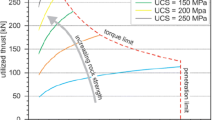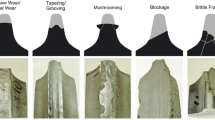Abstract
The tunnel boring machine (TBM) method has become widely used and is currently an important presence within the tunnelling industry. Large investments and high geological risk are involved using TBMs, and disc cutter consumption has a great influence on performance and cost, especially in hard rock conditions. Furthermore, reliable cutter life assessments facilitate the control of risk as well as avoiding delays and budget overruns. Since abrasive wear is the most common process affecting cutter consumption, good laboratory tests for rock abrasivity assessments are needed. A new abrasivity test method by rolling disc named Rolling Indentation Abrasion Test (RIAT) has been developed. The goal of the new test design and procedure is to reproduce wear behaviour on hard rock tunnel boring in a more realistic way than the traditionally used methods. Wear by rolling contact on intact rock samples is introduced and several rock types, covering a wide rock abrasiveness range, have been tested by RIAT. The RIAT procedure indicates a great ability of the testing method to assess abrasive wear on rolling discs. In addition and to evaluate the newly developed RIAT test method, a comprehensive laboratory testing programme including the most commonly used abrasivity test methods and the mineral composition were carried out. Relationships between the achieved results from conventional testing and RIAT results have been analysed.

















Similar content being viewed by others
Notes
The samples were analysed using a Bruker D8 ADVANCE. The phases are suggested by DIFFRAC.SUITE EVA software in combination with PDF-4 + database. Rietveld (Topas 4) is used for mineral quantification.
References
Alber M, Yarali O, Dahl F, Bruland A, Käsling H, Michalakopoulos TN, Cardu M, Hagan P, Aydin H, Özarslan A (2014) ISRM suggested method for determining the abrasivity of rock by the CERCHAR abrasivity test. Rock Mech Rock Eng 47:261–266
ASTM (2010) Standard test method for laboratory determination of abrasiveness of rock using the CERCHAR method. Designation D7625–10
Bieniawski ZT, Celada CB, Galera JM, Tardaguila IG (2009) Prediction of cutter wear using RME. ITA-ITAES World Tunnel Congress, Budapest
Bruland A (1998) Hard rock tunnel boring: vol. 8 drillability test methods. Ph.D. Thesis. Norwegian University of Science and Technology (NTNU), Trondheim, Norway
Dahl F (2003) The suggested DRI™, BWI™, CLI™ Standard. http://www.drillability.com (Visited: 10/02/2015)
Dahl F, Bruland A, Jakobsen PD, Nilsen B, Grøv E (2012) Classifications of properties influencing the drillability of rocks, based on the NTNU/SINTEF test method. Tunn Undergr Space Technol 28:150–158
Ellecosta P, Schneider S, Käsling H, Thuro K (2015) Hardness—a new method for characterising the interaction of TBM disc cutters and rocks? Proceedings of the 13th Congress on Rock Mechanics, ISRM Congress 2015. In-novation in Applied and Theoretical Rock Mechanics, May 10-13, 2015, Palais des Congrès der Montréal, Canada, Paper 688, 10 p (ISBN: 978-1-926872-25-4)
Espallargas N, Jakobsen PD, Langmaack L, Macias FJ (2015) Influence of corrosion on the abrasion of cutter steels used in TBM tunnelling. Rock Mech Rock Eng 48:261–275. doi:10.1007/s00603-014-0552-6
Frenzel C (2011) Disc Cutter Wear Phenomenology and their implications on disc cutter consumption for TBM. 45th US Rock Mechanics/Geomechanics Symposium, San Francisco, USA
Frenzel C, Kasling H, Thuro K (2008) Factors influencing Disc Cutter Wear. Geomech Tunnel 6(2008):55–60
Gehring K (1995) Leistungs- und Verschleißprognosen im maschinellen Tunnelbau. Felsbau 13–6:439–448 (in German)
Hassanpour J, Rostami J, Tarigh Azali S, Zhao J (2014) Introduction of an empirical TBM cutter wear prediction model for pyroclastic and mafic igneous rock; a case history of Karaj water conveyance tunnel, Iran. Tunnel Underground Space Technol 43(2014):222–231
ISRM International Society for Rock Mechanics (1978) Suggested methods for the quantitative description of discontinuities in rock masses–—Commission on Standardization of Laboratory and Field Tests, Document No. 4. Int J Rock Mech Min Sci Geomech Abstr 15:319–368
Jakobsen PD, Bruland A, Dahl F (2013) Review and assessment of the NTNU/SINTEF Soil Abrasion Test (SAT™) for determination of abrasiveness of soil and soft ground. Tunn Undergr Space Technol 37:107–114. doi:10.1016/j.tust.2013.04.003
Klug HP, Alexander L (1974) X-ray diffraction procedures, 2nd edn. Wiley, New York (966 p)
Lislerud A (1997) Principles of Mechanical Excavation. Possiva report 97-12, Helsinki, Finalnd. ISBN 951-652-037-5
Macias FJ, Dahl FE, Bruland A (2015) New rock abrasivity test method by rolling disc. Proceedings of the 13th Congress on Rock Mechanics, ISRM Congress 2015: In-novation in Applied and Theoretical Rock Mechanics, May 10–13, 2015, Palais des Congrès der Montréal, Canada, paper 634, 10 p (ISBN: 978-1-926872-25-4)
Maidl B, Schmidz L, Titz W, Herrenknecht M (2008) Hard rock tunnel boring machines. Ernst and Sohn, Berlin
Normalisation Française P18-579 (1990) Granulats: Essai d’ abrasivité et de broyabilité
Petrica M, Badisch E, Peinsitt T (2013) Abrasive wear and their relation to rock properties. Wear 308(2013):86–94
Plinninger RJ, Restner U (2008) Abrasiveness Testing, Quo Vadis? A commented overview of abrasiveness testing methods. Geomechanik und Tunnelbau 1(2008):61–70
Ratia V Heino V, Valtonen K, Vippola M, Kemppainen A, Siitonen P, Kuokkala V-T (2014) Effect of abrasive properties on the high-stress three-body abrasion of steels and hard metals. Finn J Tribol 1(32):3–18
Rostami J (1997) Development of a force estimation model for rock fragmentation with disc cutters through theoretical modelling and physical measurement of crushed zone pressure, PhD Thesis. Colorado School of Mines, Golden, Colorado, USA
Salminen P, Viitala R (1985) Rock Drillability Study. Helsinki University of Technology, Department of Mining and Metallurgy. Laboratory of Mining Engineering. ISBN 951-753-591-0
Thuro K (1997) Drillability prediction—geological influences in hard rock drill and blast tunnelling. Geol Rundschau 86:426–437
Thuro K, Käsling H (2009) Classification of the abrasiveness of soil and rock. Geomechanics and Tunnelling 2(2):179–188
Thuro K, Singer J, Käsling H, Bauer M (2007) Determining abrasiveness with the LCPC Test. Proceedings of the 1st Canada–U.S. Rock Mechanics Symposium, Vancouver B.C
Valantin A (1974) Description des tests CERCHAR, “Durete et abrasivite des roches”. Travaux Publics 167(322):88–92 [November 1974 (French)]
Verhoef PNW (1997) Wear of rock cutting tools. A.A. Balkema, Rotterdam (90 5410 434 1)
West (1989) Rock abrasiveness testing for tunnelling, technical note. Int J Rock Mech Min Sci Geomech Abstr 26(2):151–160
Acknowledgments
The authors would like to thank the research project “Future Advanced Steel Technology for Tunnelling” (FAST-Tunn). This project is managed by SINTEF/NTNU, and funded by the Research Council of Norway. The Robbins Company, BASF Construction Chemicals, the Norwegian Railroad Authorities, Scana Steel Stavanger, BMS steel, the LNS Group and Babendererde Engineers are industrial partners and co-founders. The authors would also like to acknowledge the SINTEF laboratory team for collaborating as well as the Department of Geology at the University of Oviedo (Spain) for providing some of the tested rock samples.
Author information
Authors and Affiliations
Corresponding author
Rights and permissions
About this article
Cite this article
Macias, F.J., Dahl, F. & Bruland, A. New Rock Abrasivity Test Method for Tool Life Assessments on Hard Rock Tunnel Boring: The Rolling Indentation Abrasion Test (RIAT). Rock Mech Rock Eng 49, 1679–1693 (2016). https://doi.org/10.1007/s00603-015-0854-3
Received:
Accepted:
Published:
Issue Date:
DOI: https://doi.org/10.1007/s00603-015-0854-3




